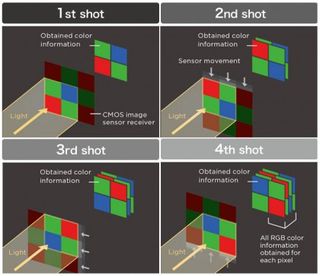Pentax full frame DSLR put back to early 2016
Pentax teaser site confirms the camera's existence but revises the launch date

We first reported on the planned Pentax full-frame DSLR back in February 2014, and a mock-up was showcased at The Photography Show a month later. But since then the camera giant has been tight-lipped about the specification, and we've been told by Pentax UK that this is not because the camera is simply a concept but because Pentax wants everything in place before the big announcement.
This means that almost nothing is known about the new camera, beyond the fact that it uses a full-frame sensor. This is big news in itself because, until now, Canon and Nikon have cornered the market in professional full-frame DSLRs.

Why full frame matters
The key point about full frame sensors is that they are twice the size of the APS-C sensors used in consumer DSLRs and compact system cameras. The larger sensor produces a more three-dimensional look to images with shallower depth of field, a by-product of the longer focal lengths used to give the same angle of view on the larger sensor area.
For the same megapixel rating, full-frame sensors will also have larger photosites, and hence less noise at higher ISOs and better dynamic range.
However, the larger sensor can instead be used to cram in more pixels without losing image quality. The 50-megapixel Canon EOS 5DS has twice the resolution of any APS-C camera, and the brand new Sony A7R II is not far behind at 42.5 megapixels. The past resolution record-holder, the 36-megapixel Nikon D810, still easily outperforms cameras with smaller sensors.

Possible sensor specs
This has led to much speculation about the sensor Pentax will use in its new full-frame camera, with most pundits expecting it to be a version of the Nikon or Sony sensors. It will also be interesting to see whether Pentax can scale up its excellent Shake Reduction (SR) image stabilization technology to fit the new camera. This has already been used in the smaller Pentax K-3 II to capture full-color image data at each photosite for improved color rendition and resolution.
Called Pixel Shift Resolution mode, this overcomes one of the principal weaknesses of conventional sensors, that they can only capture red, green or blue light at each photosite and the data has to be 'demosaiced' (mathematically interpolated) to produce full-color pixels.
Get daily insight, inspiration and deals in your inbox
Get the hottest deals available in your inbox plus news, reviews, opinion, analysis and more from the TechRadar team.
Pentax's Pixel Shift Resolution mode can currently be used only on static subjects, but if this were to be available on the new Pentax full frame DSLR it would immediately give it a small but significant technical advantage over its Canon and Nikon rivals.

What this means for the market
Sony is also emerging as a major player in the full frame market, of course, and its latest A7R II compact system camera is an interesting alternative to regular full-frame DSLRs, particularly for film-makers.
The arrival of the Pentax full frame DSLR should shake the pro market up even more, and it's good to see one of photographic industry's oldest brands coming to the fore again. It's worth pointing out, too, that with the arrival of this new camera, Pentax will be the only maker to offer interchangeable lens cameras across three sensor sizes (and three markets), with APS-C, full frame and medium format DSLRs – the Pentax 645Z is already one of our favorite medium format cameras.
